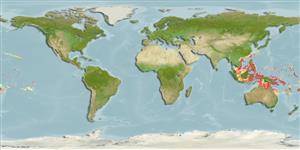Actinopterygii (ray-finned fishes) >
Perciformes (Perch-likes) >
Pomacanthidae (Angelfishes)
Etymology: Centropyge: Greek, kentron = sting + Greek, pyge = tail (Ref. 45335).
Environment / Climate / Range
Ecology
Marine; reef-associated; non-migratory; depth range 3 - 70 m (Ref. 4859). Tropical, preferred ?; 30°N - 23°S
Western Pacific: Ryukyu Islands to Indonesia, the Solomon Islands, the Great Barrier Reef and New Caledonia (Ref. 48391). Palau and Kapingamarangi in Micronesia (Ref. 1602).
Size / Weight / Age
Maturity: Lm ? range ? - ? cm
Max length : 10.0 cm TL male/unsexed; (Ref. 48636)
Common in coral-rich areas of outer reef slopes, occasionally sighted in lagoons and passages. Prefers habitats with rich mixed invertebrate growth (Ref. 48636). Usually seen singly or in pairs. It thrives well in an algae-grown tank (Ref. 4859). Feeds on algae. Forms harems of 3-7 individuals. Frequently exported through the aquarium trade (Ref. 48391).
Life cycle and mating behavior
Maturity | Reproduction | Spawning | Eggs | Fecundity | Larvae
Steene, R.C., 1978. Butterfly and angelfishes of the world. A.H. & A.W. Reed Pty Ltd., Australia. vol. 1. 144 p. (Ref. 4859)
IUCN Red List Status (Ref. 115185)
CITES (Ref. 94142)
Not Evaluated
Threat to humans
Harmless
Human uses
Aquarium: commercial
More information
Common namesSynonymsMetabolismPredatorsEcotoxicologyReproductionMaturitySpawningFecundityEggsEgg development
ReferencesAquacultureAquaculture profileStrainsGeneticsAllele frequenciesHeritabilityDiseasesProcessingMass conversion
Tools
Special reports
Download XML
Internet sources
